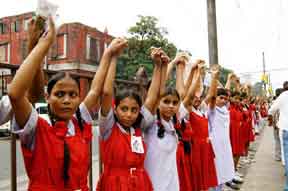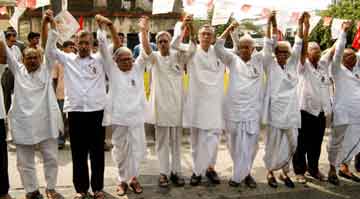 People's Democracy
People's Democracy
(Weekly
Organ of the Communist Party of India (Marxist)
No. 37
September 10, 2006
(Weekly
Organ of the Communist Party of India (Marxist)
|
Vol.
XXX
No. 37 September 10, 2006 |
AGAINST IMPERIALISM AND FOR PEACE
30 Lakh Participate In Human Chain Programme Across Bengal

B Prasant
MORE than thirty lakh of people from every section of the society participated in a Bengal Left Front programme of human chain on September 1, 2006. Deemed, said CPI(M) state secretary Biman Basu, as the climactic point of the CPI(M)’s August campaign in Bengal, the programme, anti-war, and pro-peace, was organised as part of a stringent critique of the pro-US foreign policy stand of the UPA government.
The human chain programme was organised this year as a ‘decentralised’ one, in the sense that the district LF units were given the go-ahead to organise the human chain as per the time schedule best suited to them.
The central programme was held in the districts of Kolkata, south and north 24 Parganas, and Howrah. The schedule was between 1:40 to 1:45 in the afternoon. Biman Basu led the human chain in downtown Kolkata just in front of the Muzaffar Ahmad Bhavan and accompanying him, among thousand others, were the Bengal CPI(M) and Left Front leadership. Polit Bureau member of the CPI(M), Dr M K Pandhe was also present.
Vast numbers of people lined up along the thoroughfares of Kolkata and the towns of the three districts in strident show of strength against imperialism, against war, and for peace. Posters carrying a stylistically drawn image of a white feathered bird of peace, with a sprig of flowers in its beak, covered two sides of the roads and streets and lanes where the human chain was held. Colourful red-white-blue placards and festoons, lakhs and lakhs of them, gave the clarion call against war and for peace across the globe.

Biman Basu, Benoy Konar and other Left Front leaders participating in the programme in Kolkata
The formation of the human chain was preceded by anti-war songs, rousing slogans, and by addresses of the Left Front and CPI(M) leadership. In his brief address in Kolkata, Biman Basu said that on September1, Bengal witnessed, and every year, the programme of human chain, which represented anti-war and anti-imperialist feelings of the masses. On this day, slogans against US imperialist designs would rent the air every year. The people roared out “Hands off Afghanistan, Iraq, Iran, Syria, Lebanon, Democratic Korea, and Cuba!”
Biman Basu also pointed out that US imperialists were deep into conspiring designs anew and afresh against Iran, Cuba, Syria, and Democratic Korea. He noted how there was need for the mass of the people to stand united in opposition and condemnation of the designs of Bush and his adherents of the imperialist camp.
Biman Basu said that one programme, however successful, was never sufficient in any manner to stem the rush of imperialist assaults. The anti-imperialist struggle has to be a continuous process with efforts taken up all the while to enhance the political consciousness of the masses. The people must realise the innate dangers contained in imperialism.
A notable feature of the human chain programme on September 1 has always been the large, overwhelmingly large, participation of school children, girls and boys who would come out donning their school uniform and the make the occasion a befitting one as one looked to the future. This year was no exception.
One found thousands upon thousands of school children braving the sun standing cheerfully in line on the side of the Barrackpore trunk Road right from Sinthee crossing, and way beyond deep into north 24 Parganas and stretching right into the Shyambazar crossing on the gateway to north Kolkata, a distance covering more than 20 kilometres.
It was remarkable how the children themselves would come forward and direct the traffic to keep the flow moving and there was no traffic snarl anywhere. The scions of the corporate media, and their corporate bosses, to whom any and every programme of the CPI(M) and the Left Front would merit bytes and column spaces only for reasons of traffic dislocation, real or imagined, mostly the latter, must have been sorely disappointed. The human chain also saw the participation in lakhs by women.
Deep in the southern fringe of the Sunderbans mangroves, the human chain was formed across and between the many small islands that dominate the innumerable creeks. Oats were lashed together sometimes to form the plat form of which people climbed and held hands across the stretches of water between the forestry.
At the other end, the cool of the Himalayas saw the hilly areas linked up with the dooars and the terai as the people held hands against imperialism. In the industrial belts of the state, workers came out in their thousands everywhere to cover hundreds of kilometres of road spaces, standing by the side of the thoroughfares in solidarity for peace and against war.
The human chain in tribal areas in the red clay districts saw the people thump the kettle drum and play the flute. The massive participation in the district of Hooghly was a blow against the disruptive designs of the Bengal opposition to try to scuttle the process of industrialisation in the district.
From the mountains to the swishing waves of the southern coastline, the state of Bengal stood solidly against war and for peace, against destruction and for creation on September 1.